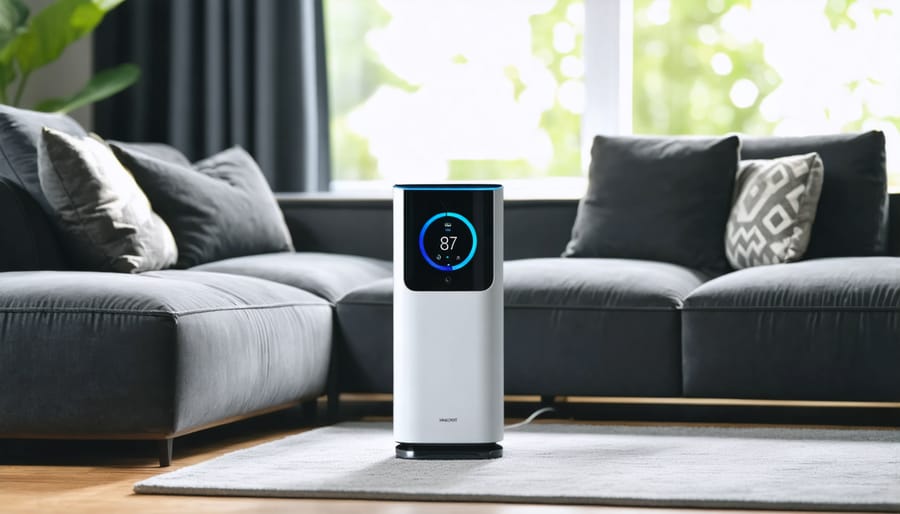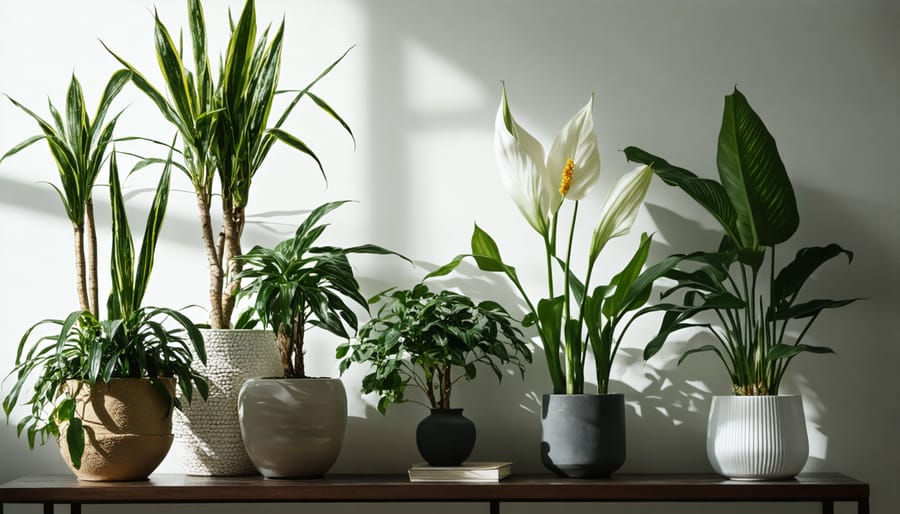Transform your home’s air quality dramatically by implementing proven biophilic design principles and strategic ventilation techniques. Install HEPA air purifiers in high-traffic areas, focusing on bedrooms and living spaces where you spend the most time. Monitor indoor humidity levels between 30-50% using quality hygrometers, and introduce air-purifying plants like snake plants and spider plants in key locations. Regular HVAC maintenance, combined with proper air filter replacement every 60-90 days, creates a foundation for pristine indoor air.
Poor indoor air quality affects everything from sleep quality to cognitive function, making it a crucial yet often overlooked aspect of home wellness. Modern homes, designed for energy efficiency, can trap pollutants, allergens, and VOCs, creating an environment up to five times more polluted than outdoor air. Taking control of your home’s air quality isn’t just about comfort—it’s an investment in your family’s long-term health and well-being.
By implementing strategic air quality improvements, you’re not just clearing the air; you’re creating a healthier, more vibrant living space that supports optimal physical and mental wellness.
Common Indoor Air Pollutants: Know Your Enemy
Hidden Sources of Indoor Air Pollution
While many of us are aware of common pollutants like smoke and pet dander, your home might harbor several unexpected sources of air contamination. That beautiful new furniture set could be releasing formaldehyde through a process called off-gassing. Your cozy scented candles and air fresheners, while creating a pleasant atmosphere, may actually be introducing volatile organic compounds (VOCs) into your air.
Even everyday activities can contribute to poor air quality. Cooking with a gas stove releases nitrogen dioxide and other pollutants, while that steamy morning shower can create excess moisture that leads to mold growth. Your cleaning supplies, though essential for maintaining a hygienic home, might be releasing harmful chemicals into the air.
Perhaps most surprisingly, some indoor plants, despite their air-purifying reputation, can harbor mold in their soil when overwatered. Even your craft supplies, like glues and paints, and hobby materials can release unexpected pollutants. Being aware of these hidden sources is the first step toward creating a healthier indoor environment.

Health Impacts of Poor Air Quality
Poor indoor air quality can have serious effects on your family’s health and well-being. When you breathe in polluted indoor air, you might experience immediate symptoms like headaches, dizziness, and irritation of the eyes, nose, and throat. For many people, these symptoms may feel like a common cold or allergies, making them easy to dismiss.
However, long-term exposure to indoor air pollutants can lead to more severe health issues. Respiratory conditions like asthma and bronchitis can develop or worsen, particularly in children and elderly family members. Heart disease risks may increase, and some pollutants have been linked to cognitive problems and decreased productivity.
People with existing health conditions, pregnant women, and young children are especially vulnerable to poor indoor air quality. Common indoor pollutants like mold spores can trigger allergic reactions and respiratory problems, while carbon monoxide can cause dangerous symptoms ranging from dizziness to unconsciousness.
The good news is that most indoor air quality issues can be addressed with proper ventilation, regular cleaning, and appropriate air filtration systems. Being aware of these health impacts helps you take informed steps to protect your family’s well-being.
Smart Air Quality Improvement Strategies
Natural Ventilation Techniques
Natural ventilation is one of the most effective and eco-friendly ways to improve your indoor air quality while creating a natural oasis in your home. Start by implementing the cross-ventilation technique: open windows on opposite sides of your house to create a refreshing airflow that pushes stale air out while drawing fresh air in.
Strategic window placement is key – open upper-floor windows during warm days to release hot air that naturally rises, while keeping ground-floor windows slightly open to pull in cooler air. During mild weather, try the stack effect by opening windows at different heights to create natural air movement throughout your home.
Make the most of your home’s design by using window screens to keep insects out while maintaining airflow. Position indoor plants near windows to naturally filter incoming air, and use window fans strategically during cooler hours to boost air circulation. Remember to adjust your ventilation routine based on outdoor air quality and weather conditions – early morning and evening hours typically offer the cleanest air for ventilation.
Air Purification Systems
Air purification systems are your first line of defense against indoor air pollutants, offering a reliable way to breathe cleaner, healthier air at home. These devices come in several types, each designed to target specific air quality concerns.
HEPA (High-Efficiency Particulate Air) purifiers are the gold standard for removing airborne particles. These workhorses capture 99.97% of particles as small as 0.3 microns, including dust, pollen, pet dander, and some bacteria. They’re particularly effective for allergy and asthma sufferers.
Activated carbon filters excel at absorbing odors, gases, and volatile organic compounds (VOCs). They’re your best bet for eliminating cooking smells, pet odors, and harmful chemicals released by household products. Many modern purifiers combine HEPA and activated carbon technologies for comprehensive air cleaning.
UV-C light purifiers add another layer of protection by neutralizing airborne pathogens. While they work best alongside particle filtration, they’re especially valuable in rooms prone to moisture and potential mold growth, like bathrooms and basements.
For tech-savvy homeowners, smart air purifiers offer convenient features like air quality monitoring, automatic mode adjustment, and mobile app control. These systems can automatically increase filtration when they detect poor air quality, making them essentially set-and-forget solutions.
When choosing an air purifier, consider the size of your space and the specific air quality issues you’re facing. Look for models with a Clean Air Delivery Rate (CADR) appropriate for your room size, and remember that placing multiple smaller units throughout your home often works better than relying on a single large unit.
Remember to maintain your air purifier by regularly replacing filters according to the manufacturer’s recommendations to ensure optimal performance.

Air-Cleaning Plants
Transform your home into a natural wellness sanctuary with these powerful air-purifying plants. Nature’s own air filters not only add beauty to your space but also work tirelessly to remove common indoor pollutants.
The NASA-studied Spider Plant (Chlorophytum comosum) is perfect for beginners, thriving in indirect light while removing formaldehyde and xylene from your air. Place these hardy plants in hanging baskets for a stunning display that doubles as an air purifier.
Snake Plants (Sansevieria) are practically indestructible and work overtime – they’re one of the few plants that convert CO2 to oxygen at night. Perfect for bedrooms, they also filter out benzene, formaldehyde, and trichloroethylene.
Don’t overlook the Peace Lily (Spathiphyllum), which excels at removing common household toxins while adding elegant white blooms to your décor. Just keep it away from pets, as it can be toxic if ingested.
For larger spaces, consider the dramatic Rubber Plant (Ficus elastica) or the statement-making Boston Fern. Both are excellent at maintaining healthy humidity levels and filtering air pollutants.
Position these plants strategically throughout your home, focusing on areas where you spend the most time. Remember to dust their leaves monthly to maximize their air-cleaning efficiency, and maintain proper watering schedules for optimal performance.

Maintenance Tips for Optimal Air Quality
HVAC System Care
Your HVAC system plays a vital role in maintaining healthy indoor air quality, and proper maintenance is key to keeping it running efficiently. Start with regular filter changes every 1-3 months, depending on your household conditions and filter type. Choose high-quality filters with a MERV rating between 8 and 13 for optimal air cleaning without straining your system.
Keep your air vents and returns clear of furniture, curtains, and other obstacles to ensure proper airflow throughout your home. Regularly vacuum and dust around vents to prevent debris from entering your system. Don’t forget to clean your outdoor unit by removing leaves, twigs, and other debris that might restrict airflow.
Schedule professional HVAC maintenance twice yearly – typically in spring and fall – to prepare for peak cooling and heating seasons. During these check-ups, technicians will clean vital components, check refrigerant levels, and identify potential issues before they become major problems.
Consider installing a whole-home humidifier or dehumidifier to maintain optimal moisture levels, as proper humidity is crucial for both comfort and air quality. Keep your indoor humidity between 30-50% to discourage mold growth and dust mites.
Pay attention to unusual sounds, odors, or performance changes in your HVAC system. Strange smells or noises often indicate problems that need immediate attention. Regular maintenance not only improves air quality but also extends your system’s lifespan and reduces energy costs.
For optimal results, combine HVAC maintenance with other air quality improvements like regular cleaning, proper ventilation, and using air-purifying plants. This comprehensive approach will help create a healthier indoor environment for you and your family.
Humidity Control
Maintaining proper humidity levels in your home is crucial for both comfort and health. The ideal indoor humidity range falls between 30% and 50%, striking a perfect balance that discourages mold growth while keeping your living space comfortable.
To control humidity effectively, start by monitoring your home’s levels with a hygrometer – an inexpensive device available at most hardware stores. Once you know where you stand, you can take appropriate action. For high humidity, consider these solutions:
• Use dehumidifiers in problem areas like basements
• Run bathroom exhaust fans during and after showers
• Ensure proper ventilation in your kitchen while cooking
• Fix any leaks or water infiltration promptly
• Keep air conditioning units well-maintained
For low humidity issues, try these methods:
• Install whole-house or portable humidifiers
• Place water containers near heating vents
• Add indoor plants to naturally increase moisture
• Use bowl-style evaporative humidifiers in bedrooms
• Leave bathroom doors open after showers
Seasonal changes often require different approaches. During summer, focus on reducing humidity by running your air conditioner and using dehumidifiers. In winter, when heating systems dry out the air, emphasize humidity addition through various methods.
Remember to pay special attention to your bathroom and kitchen ventilation systems, as these areas typically generate the most moisture. Regular maintenance of these systems ensures they function effectively when needed. By actively managing your home’s humidity levels, you’ll create a healthier living environment and protect your home from moisture-related damage.
Smart Technology for Air Quality Monitoring
Modern technology has revolutionized how we monitor and maintain indoor air quality, making it easier than ever to create a healthier home environment. Smart air quality monitors have become an essential part of smart wellness features in today’s homes, offering real-time insights into what we’re breathing.
These intelligent devices can detect various pollutants, including particulate matter (PM2.5 and PM10), volatile organic compounds (VOCs), carbon dioxide, and humidity levels. Many models connect to your smartphone through user-friendly apps, sending instant alerts when air quality drops below acceptable levels.
Popular features of modern air quality monitors include:
– 24/7 continuous monitoring
– Historical data tracking
– Custom alerts and notifications
– Integration with smart home systems
– Automatic activation of air purifiers
– Weather forecasting capabilities
Some advanced systems can even learn your daily routines and automatically adjust your home’s ventilation. For example, if cooking activities typically spike VOC levels around dinner time, the system can automatically increase ventilation during these hours.
When choosing a smart air quality monitor, look for devices that measure multiple pollutants and offer clear, actionable feedback. Many affordable options start around $100, while more comprehensive systems might range from $200-500.
To make the most of your smart air quality monitor:
– Place sensors in frequently used rooms
– Keep devices away from direct airflow
– Regular calibrate and clean sensors
– Set up custom alerts for specific concerns
– Review historical data to identify patterns
– Connect with other smart devices for automated responses
Remember that while these devices provide valuable information, they work best as part of a comprehensive air quality management strategy. Use the data they provide to make informed decisions about ventilation, cleaning schedules, and air purification needs in your home.
Taking control of your home’s air quality is one of the most important steps you can take for your family’s health and comfort. By implementing the strategies we’ve discussed – from regular HVAC maintenance to using air purifiers and maintaining proper ventilation – you can create a healthier indoor environment. Remember that improving air quality is an ongoing process, not a one-time fix. Start with simple changes like regular cleaning and proper ventilation, then gradually incorporate more comprehensive solutions as needed. Monitor your air quality regularly, pay attention to how you and your family feel, and adjust your approach accordingly. With consistent effort and the right tools, you can significantly enhance the air quality in your home and enjoy the benefits of cleaner, fresher air every day.
